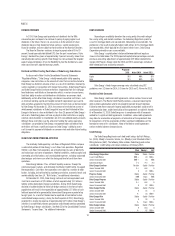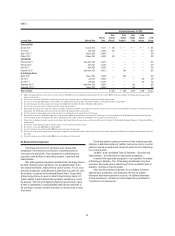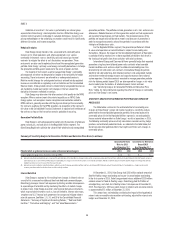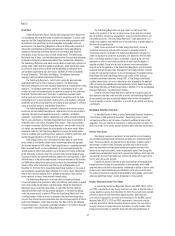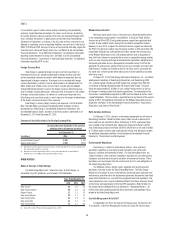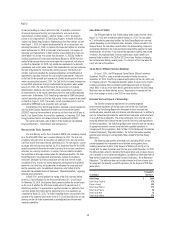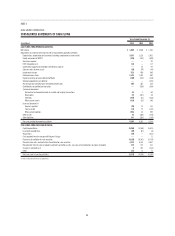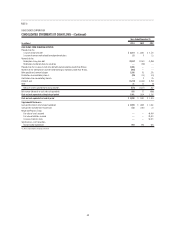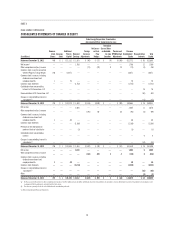Duke Energy 2014 Annual Report Download - page 80
Download and view the complete annual report
Please find page 80 of the 2014 Duke Energy annual report below. You can navigate through the pages in the report by either clicking on the pages listed below, or by using the keyword search tool below to find specific information within the annual report.
60
PART II
Coal Combustion Residuals
On December 19, 2014, the EPA signed the fi rst federal regulation for the
disposal of CCR from power plants. The federal regulation classifi es CCR as
nonhazardous waste under the Resource Conservation and Recovery Act. The
regulation applies to all new and existing landfi lls, new and existing surface
impoundments, structural fi lls and CCR piles. The rule establishes requirements
regarding landfi ll design, structural integrity design and assessment criteria
for surface impoundments, groundwater monitoring and protection procedures
and other operational and reporting procedures to ensure the safe disposal
and management of CCR. In addition to the requirements of the federal
CCR regulation, CCR landfi lls and surface impoundments will continue to
be independently regulated by most states. Duke Energy records an asset
retirement obligation when it has a legal obligation to incur retirement costs
associated with the retirement of a long-lived asset and the obligation can
be reasonably estimated. Once the rule is effective in 2015, additional asset
retirement obligation amounts will be recorded at all Duke registrants. Cost
recovery for future expenditures will be pursued through the normal ratemaking
process with state utility commissions, which permit recovery of necessary and
prudently incurred costs associated with Duke Energy’s regulated operations.
At this time, Duke Energy is evaluating the CCR regulation and developing cost
estimates that will largely be dependent upon compliance alternatives selected
to meet requirements of the regulations. For more information, see Note 5
to the Condensed Consolidated Financial Statements, “Commitments and
Contingencies.”
Cross-State Air Pollution Rule
On August 8, 2011, the fi nal Cross-State Air Pollution Rule (CSAPR) was
published in the Federal Register. The CSAPR established state-level annual
sulfur dioxide (SO2) budgets and annual and seasonal nitrogen oxide (NOx)
budgets that were to take effect on January 1, 2012.
On August 21, 2012, the D.C. Circuit Court vacated the CSAPR. The court
also directed the EPA to continue administering the Clean Air Interstate Rule
(CAIR), which required additional reductions in SO2 and NOx emissions beginning
in 2015. On April 29, 2014, the U.S. Supreme Court (Supreme Court) reversed
the D.C. Circuit Court’s decision, fi nding that with CSAPR the EPA reasonably
interpreted the good neighbor provision of the CAA. The case was remanded
to the D.C. Circuit Court for further proceedings consistent with the Supreme
Court’s opinion. On October 23, 2014, the D.C. Circuit Court lifted the CSAPR
stay, which allowed Phase 1 of the rule to take effect on January 1, 2015,
terminating the CAIR. Where the CSAPR requirements are constraining, actions
to meet the requirements could include purchasing emission allowances, power
purchases, curtailing generation and utilizing low sulfur fuel. The CSAPR will not
result in Duke Energy Registrants adding new emission controls.
Additional challenges to the CSAPR fi led in 2012, not addressed by the
D.C. Circuit Court decision to vacate the CSAPR, are still ongoing. Oral arguments
were held February 25, 2015. The Duke Energy Registrants cannot predict the
outcome of these proceedings or how the requirements of the CSAPR may be
impacted going forward.
Carbon Dioxide New Source Performance Standards
On January 8, 2014, the EPA proposed a rule to establish carbon dioxide
(CO2) emissions standards for new pulverized coal, IGCC, natural gas combined
cycle, and simple cycle electric generating units commencing construction on
or after that date. Based on the proposal, future coal and IGCC units will be
required to employ carbon capture and storage technology to meet the proposed
standard.
In January 2015, the EPA announced that it would fi nalize the rule for new
power plants in the summer of 2015. The Duke Energy Registrants do not expect
a material impact on their future results of operations or cash fl ows based on the
EPA’s proposal. The fi nal rule, however, could be signifi cantly different from the
proposal.
CO2 Existing Source Performance Standards and Standards for
Reconstructed and Modifi ed Units
On June 18, 2014, the EPA’s proposed Clean Power Plan (CPP) for
regulating CO2 emissions from existing fossil fuel-fi red electric generating
units (EGUs) was published in the Federal Register. On the same date the EPA
proposed carbon pollution standards for reconstructed and modifi ed EGUs. The
comment period ended October 16, 2014 for the reconstructed and modifi ed
proposal and December 1, 2014 for the CPP. Duke Energy submitted comments
on both proposals. In January 2015 the EPA announced that it would fi nalize both
proposals in the summer of 2015.
Once the CPP is fi nalized, states will be required to develop plans to
implement its requirements. The CPP will not directly impose any regulatory
requirements on Duke Energy Registrants. State implementation plans will
include the regulatory requirements that will apply to Duke Energy Registrants.
Based on the EPA’s June 18, 2014 proposal, states will have from one to three
years after the CPP is fi nalized to submit a plan for EPA’s review. In January
2015 the EPA announced that it would also propose a federal implementation
plan for public comment in the summer of 2015. A federal plan would be EPA’s
plan for meeting the requirements of the CPP and could take the place of a state
plan if a state either fails to submit a plan or submits a plan that is not approved
by the EPA.
The EPA has proposed to phase CO2 emission reductions in over the
period 2020 to 2030. The fi nal requirements of the CPP, however, including
the implementation schedule are uncertain and could be signifi cantly different
from the proposal. In addition, it will be several years before the requirements
of the subsequent state plans are known. Also unknown at this time are the
requirements of any federal plan that might be imposed on states in which the
Duke Energy Registrants operate should a state fail to submit a plan or have their
plan disapproved by the EPA. The Duke Energy Registrants are therefore unable
to predict the outcome of this rulemaking, or how it might impact them, but the
impact could be signifi cant.
Global Climate Change
The Duke Energy Registrants’ greenhouse gas (GHG) emissions consist
primarily of CO2 with most coming from their fl eet of coal-fi red power plants
in the U.S. In 2014, the Duke Energy Registrants’ U.S. power plants emitted
approximately 135 million tons of CO2. CO2 emissions from Duke Energy’s
international operations were approximately 2 million tons. The Duke Energy
Registrants’ future CO2 emissions will be infl uenced by variables including new
regulations, economic conditions that affect electricity demand, and the Duke
Energy Registrants’ decisions regarding generation technologies deployed to meet
customer electricity needs.
The Duke Energy Registrants are taking actions that will result in reduced
GHG emissions over time. These actions will lower the Duke Energy Registrants’
exposure to any future mandatory GHG emission reduction requirements or
carbon tax, whether a result of federal legislation or EPA regulation. Under
any future scenario involving mandatory GHG limitations, the Duke Energy
Registrants would plan to seek recovery of compliance costs associated with
their regulated operations through appropriate regulatory mechanisms.
The Duke Energy Registrants recognize certain groups associate severe
weather events with climate change, and forecast the possibility these weather
events could have a material impact on future results of operations should they
occur more frequently and with greater severity. However, the uncertain nature
of potential changes of extreme weather events (such as increased frequency,
duration, and severity), the long period of time over which any potential
changes might take place, and the inability to predict these with any degree of
accuracy, make estimating any potential future fi nancial risk to the Duke Energy
Registrants’ impossible. Currently, the Duke Energy Registrants plan and prepare
for extreme weather events they experience from time to time, such as ice
storms, tornadoes, hurricanes, severe thunderstorms, high winds and droughts.



